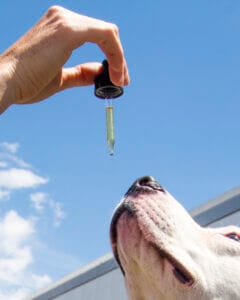The presence and concentration of CB1 and CB2 receptors differ across various tissues in the body, affecting their respective roles and functions. CB1 receptors are mainly located in the brain, significantly impacting cognition, motor skills, and emotion. CB2 receptors are most abundant in immune cells and peripheral tissues, where they are key players in supporting the immune response and promoting normal inflammatory pathways. These distinct differences show how each receptor is of equal importance despite working with different parts of the mammalian body.
Significant Interest in the Endocannabinoid System
When the endogenous cannabinoid system was discovered, it was deemed a cornerstone of cannabinoid physiology that plays a critical role in maintaining homeostasis within the human body. Since it’s discovery, researchers have found the endogenous cannabinoid system to be not only in humans, but in all mammals, including our pets.
This complex system, comprising endogenous cannabinoids (endocannabinoids), the human cannabinoid receptors (and our pet’s), and their associated signaling mechanisms, has captivated the scientific community’s interest. Through the differential activation of these receptors, scientific understanding of their functions—ranging from the modulation of neuronal viability to the nuances of receptor internalization—continues to grow.
CB1 and CB2 Receptors Promote Homeostasis
CB1 and CB2 receptors are types of protein that are embedded in the cell membrane, primarily on the cell surface. The cell membrane acts as a critical barrier and gatekeeper for cellular communication and signal transduction (we’ll talk more about in a moment).
The CB1 and CB2 receptors have pivotal roles in maintaining homeostasis (you can think of this as another word for balance) in pets, serving as integral components of the body’s endocannabinoid system. This elaborate system plays a key role in regulating a range of physiological processes and affects everything from the cardiovascular system to the individual cell.
The interaction between these receptors and the endocannabinoid system ensures the regulation and balance of these critical functions, helping maintain the general health of all ages and breeds. Understanding the contribution of CB1 and CB2 receptors to this balance is essential for recognizing their importance in sustaining the internal stability necessary to help keep dogs in peak condition.
The Endocannabinoid Signaling System
The endocannabinoid system functions as a complex signaling mechanism within pets, utilizing endocannabinoids as retrograde messengers to adjust the release of neurotransmitters in the brain.
Anandamide stands out as a crucial endocannabinoid that partially activates CB1 and CB2 receptors, playing a significant role in supporting emotional balance. Research involving rabbits has demonstrated how anandamide’s interaction with CB1 receptors affects memory and emotional behavior, which shows the extensive influence of endocannabinoids on behavior regulation.
Ligand Binding Affects Signaling Pathways
Ligand binding to cannabinoid receptors initiates a series of cellular responses that modulate physiological functions in pets. When a ligand binds to a cannabinoid receptor, it induces a conformational change in the receptor structure, leading to the activation of downstream signaling pathways. In a study on mice, the binding of a cannabinoid ligand to CB1 receptors was shown to trigger a cascade of intracellular events that modulated neurotransmitter release and synaptic plasticity, influencing cognitive functions.
The binding affinity of ligands to cannabinoid receptors determines their potency and efficacy in modulating cellular responses, highlighting the specificity of ligand-receptor interactions in the endocannabinoid system. By elucidating the mechanisms of ligand binding, researchers can develop targeted therapies that optimize the efficacy of cannabinoid-based options for companion animals.
Ligand Binding May Inhibit Neurotransmitters
Ligand binding to cannabinoid receptors can result in the inhibition of adenylyl cyclase activity and modulation of calcium channels, influencing cellular excitability and neurotransmitter release. In a study on dogs, the activation of CB1 receptors by specific ligands was found to inhibit adenylyl cyclase activity, leading to the modulation of synaptic transmission and pain perception.
This intricate process of ligand binding and receptor activation plays a critical role in regulating physiological functions such as pain perception, immune responses, and appetite control in pets. By understanding the significance of ligand binding in the endocannabinoid system, researchers can develop targeted interventions that modulate cellular processes and promote overall well-being.
Examining the Enzymes Involved With ATP in the ECS
Adenylate cyclase is an enzyme involved in the conversion of ATP (adenosine triphosphate) to cAMP (cyclic adenosine monophosphate), a crucial secondary messenger in cellular signaling pathways. The relationship between adenylate cyclase and CB1 and CB2 cannabinoid receptors in pets (and in mammals in general) is significant because these receptors, when activated, modulate adenylate cyclase’s activity, affecting various physiological processes.
CB1 receptors are primarily located in the central nervous system and, to a lesser extent, in other mammalian tissues. When activated by endocannabinoids or other cannabinoids, CB1 receptors typically inhibit adenylate cyclase through their interaction with g proteins. This inhibition leads to a decrease in cAMP levels within the cell.
Because cAMP is involved in the activation of protein kinase A (PKA) and the regulation of ion channels, among other functions, its reduction has widespread effects on cellular activity, including decreased neurotransmitter release and modulation of pain perception.
The impact of CB2 receptors on adenylate cyclase is more variable and can depend on the specific cell type and signaling context. CB2 receptors are mainly associated with the immune system, and their activation can also lead to the inhibition of adenylate cyclase in some contexts, similar to CB1 receptors.
The overall impact of CB2 receptor activation on adenylate cyclase and subsequent intracellular cAMP levels can be complex and is less understood than that of CB1 receptors.
Endocannabinoid Modulation and CB1 Receptors in Dogs
Predominantly located in the brain regions, specifically in the basal ganglia, and the spinal cord, CB1 receptors play a crucial role in regulating neurotransmitter release. These receptors, embedded in the plasma membrane of presynaptic and axonal compartments, are integral to cannabinoid receptor signaling. Activation of CB1 receptors can modulate synaptic transmission and neuronal excitability, influencing various cognitive functions.
A hallmark feature of cannabinoid CB1 receptor function is receptor desensitization, a process modulated through the constitutive endocytic cycle. This mechanism ensures that the receptor’s response to endogenous cannabinoids is finely tuned, preventing overactivation. In cell culture models, the study of CB1 receptor desensitization provides insights into the complex interplay between endocannabinoids and receptor activity.
Dysregulation of cannabinoid CB1 receptors may contribute to imbalance in the body. In dogs, alterations in CB1 receptor activity have been associated with behavioral changes, indicating the potential implications of CB1 receptor dysfunction. CB1 receptor activation can also modulate sensory perception.
How CB2 Receptors in Dogs Affect the Body
CB2 receptors are primarily located in immune cell types and peripheral tissues, supporting immune system function and supporting a healthy inflammatory response in pets. The activation of CB2 receptors can enhance the immune system response and support tissue health, which contribute to their role in maintaining homeostasis. In a study involving ferrets, targeting CB2 receptors was found to promote normal inflammatory pathways, which may help protect the body’s cells and tissues.
Differences Between CB1 and CB2 Receptors
CB1 receptors are predominantly coupled to inhibitory G proteins, affecting neurotransmitter release and synaptic plasticity in pets. The intracellular localization of CB1 receptors, along with their presence in the endoplasmic reticulum and transmembrane regions, shows their significance in GPCR (G protein-coupled receptor) signaling.
In contrast, CB2 receptors are more associated with immune modulation and have limited expression in the brain and spinal cord, focusing on promoting normal inflammatory responses.
CB1 receptors are primarily responsible for the cannabinoids helping maintain normal nervous system function, while CB2 receptors are not associated with such effects. This distinction is crucial in understanding how different cannabinoids interact with these receptors to produce specific responses in animals.
Why CB2 Is the Lesser Known Receptor
The comparative lack of understanding surrounding the CB2 receptor, as opposed to the CB1 receptor, can be attributed to a confluence of historical, biological, and research-oriented factors. From a historical standpoint, the CB1 receptor was identified and cloned prior to the CB2 receptor, affording early researchers a foundational advantage in exploring its functional mechanisms. This precedence facilitated a richer research corpus regarding CB1, with a particular emphasis on its involvement in the central nervous system.
Biologically, the CB1 receptors’ predominant localization in the central nervous system has garnered significant scientific interest, especially in the context of medical and recreational cannabis usage. This focus has, in turn, influenced research directions, emphasizing studies on CB1 due to its direct relevance to cannabis’s neurological and behavioral effects.
The intricacies of the immune system, where CB2 receptors are significantly active, add a layer of complexity to their study. The immune system’s elaborate nature and relative inaccessibility for direct experimentation pose challenges in precisely characterizing the actions and impacts of CB2 receptor activation.
The allocation of research funding and scholarly interest has traditionally favored the exploration of substances and their neural impacts, thus inclining the body of cannabinoid research towards CB1 receptors. It is only in recent times that CB2 receptors have begun to gain scholarly traction.
The initial constraints posed by available research technologies and methodologies may have also restricted the scope of investigation into CB2 receptors. Now, advancements in scientific techniques, including genetic engineering, molecular biology, and imaging technologies, have significantly enhanced the ability for researchers to examine this receptor further.
The Role of Endocannabinoids in Pets
Endocannabinoids, like anandamide and 2-arachidonoyglyerol (2-AG), act as natural cannabinoid ligands for CB1 and CB2 receptors. These compounds can significantly impact an animal’s body in a positive manner.
Impact of the Cannabis Plant on the Central Nervous System (CNS) and Nerve Cells
The cannabis plant exerts a profound influence across various bodily systems, yet it is imperative to show the central nervous system’s pivotal role as the body’s “control center” in discussions surrounding the functioning of the Endocannabinoid System (ECS).
The endocannabinoid system plays a critical role in maintaining homeostasis in the central nervous system (CNS) of pets by modulating neurotransmitter release and synaptic plasticity. Since cannabinoid CB1 receptors are most abundant in the central nervous system, they could be responsible for the following effects of full spectrum Hemp Extract or CBD for dogs & cats:
- Helping reduce the effects of normal environmental stress
- Promoting a sense of relaxation and mental alertness without drowsiness
- Providing help for restless animals
- Supporting normal emotional balance
- Helping cope with external stresses
- Helping maintain contentment during separation, travel, motion sickness and tension caused by changes in your pet’s daily routine
By targeting cannabinoid receptors in the CNS with cannabinoids like CBD for dogs and cats, the endocannabinoid system can influence various processes and help maintain normal nervous system function.
Enzymatic Regulation of the ECS
Enzymes play a significant role in regulating the endocannabinoid system by modulating the metabolism of endocannabinoids and influencing their signaling pathways in pets. For example, in a study on dogs, the enzyme fatty acid amide hydrolase (FAAH) was found to degrade anandamide, maintaining endocannabinoid tone and preventing excessive cannabinoid signaling.
FAAH activity is crucial for controlling the levels of anandamide and ensuring proper endocannabinoid signaling in the body. Similarly, monoacylglycerol acid lipase (MGL), another key enzyme, regulates the metabolism of 2-arachidonoylglycerol (2-AG), impacting its levels and duration of action.
Advances in Veterinary Research
Recent studies on the endocannabinoid system in veterinary species have expanded our understanding of cannabinoid receptor distribution, endocannabinoid metabolism, and physiological functions in pets. Comparative studies across different animal species have revealed species-specific differences in receptor expression patterns and ligand affinities, shedding light on the diverse roles of cannabinoid receptors in companion animals.
Cell Culture to Examine CB1 and CB2
Cell culture is a sophisticated laboratory technique that enables researchers to cultivate cells within a controlled setting outside their natural biological context. This approach is particularly valuable for delving into the functions, signaling pathways, and pharmacological aspects of CB1 and CB2 receptors in pets.
One of the primary advantages of cell culture is the ability to isolate specific cell types that express these receptors. Such isolation simplifies the study of the receptors’ functions by removing the complexities associated with the entire organism. This controlled environment also permits the introduction of cannabinoids to observe the nuanced responses of these receptors to various stimuli.
Cell culture facilitates pharmacological testing, allowing scientists to examine the impact of both synthetic and natural cannabinoids on CB1 and CB2 receptors. This exploration is crucial for uncovering potential cannabinoid-based applications for pets, targeting concerns in the veterinary community.
Cell culture models are instrumental in investigating the behavior of these receptors, including their activation or inhibition, the process of receptor internalization post-activation, and their involvement in cellular signaling pathways.
Continuing to Learn About Cannabinoid Receptors
The exploration of the endogenous cannabinoid system, particularly the roles of CB1 and CB2 receptors, continues to provide valuable insights into cannabinoid physiology. The identification of specific binding sites on these receptors opens up new avenues for the development of agents that can modulate endocannabinoid signaling with precision.
As research progresses, the potential for harnessing the power of plant-based cannabinoids and endogenous cannabinoids and receptor signaling to influence neuronal viability and support immune function becomes increasingly apparent.
For further reading, we recommend:
- https://www.ncbi.nlm.nih.gov/pmc/articles/PMC8945712/
- https://www.nature.com/articles/s41598-017-07460-w
- https://www.ncbi.nlm.nih.gov/pmc/articles/PMC4604172/
- https://www.ncbi.nlm.nih.gov/pmc/articles/PMC4120766/
- https://www.ncbi.nlm.nih.gov/pmc/articles/PMC2219532/
- https://pubmed.ncbi.nlm.nih.gov/16709443/
- https://pubmed.ncbi.nlm.nih.gov/16553616/
- https://www.ncbi.nlm.nih.gov/pmc/articles/PMC5436336/
- https://www.ncbi.nlm.nih.gov/pmc/articles/PMC5877694/
- https://www.frontiersin.org/articles/10.3389/fncel.2016.00294/full
- https://www.sciencedirect.com/science/article/abs/pii/S0952327801903448
You Might Also Enjoy
Reactive dog barking may sound intimidating, but it’s important to differentiate it from dog aggression.…
Your dog’s skin is their largest organ making dog skin care a crucial part of…
Like us, our dogs, and other mammalian species, cats have an endocannabinoid system. This system…







